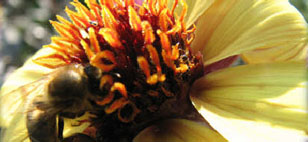Illinois’ Pollinatarium, A Discovery Science Center, Is Abuzz About Pollination
October 23, 2009
 The first free-standing Discovery Science Center in the nation devoted to flowering plants and their pollinators, Illinois’ new Pollinatarium is dedicated to increasing awareness and appreciation of pollination as a remarkable ecological partnership and an essential ecosystem service that sustains all kinds of communities around the world. Because most life on earth depends in one way or another on pollination, studying the ecological interaction between pollinators and plants is vitally important. Over 75% of all flowering plant species depend on animal pollinators in order to reproduce. And since about one third of the diet consumed by people around the world—the part with most of the vitamins and minerals—is the result of the pollinator-plant interaction, we humans also depend on pollinators for our existence. Also important economically, pollination contributes around $20 billion to the US economy and over $200 billion worldwide. Because the general public’s knowledge about pollination and its importance is surprisingly low, the University’s Department of Entomology was motivated to create a science center devoted to pollinators and pollination. Thus, the Pollinatarium is dedicated to all creatures— 2-, 4-, or 6-legged—that assist flowering plants to meet their reproductive needs.
The first free-standing Discovery Science Center in the nation devoted to flowering plants and their pollinators, Illinois’ new Pollinatarium is dedicated to increasing awareness and appreciation of pollination as a remarkable ecological partnership and an essential ecosystem service that sustains all kinds of communities around the world. Because most life on earth depends in one way or another on pollination, studying the ecological interaction between pollinators and plants is vitally important. Over 75% of all flowering plant species depend on animal pollinators in order to reproduce. And since about one third of the diet consumed by people around the world—the part with most of the vitamins and minerals—is the result of the pollinator-plant interaction, we humans also depend on pollinators for our existence. Also important economically, pollination contributes around $20 billion to the US economy and over $200 billion worldwide. Because the general public’s knowledge about pollination and its importance is surprisingly low, the University’s Department of Entomology was motivated to create a science center devoted to pollinators and pollination. Thus, the Pollinatarium is dedicated to all creatures— 2-, 4-, or 6-legged—that assist flowering plants to meet their reproductive needs.
It is hoped that the Pollinatarium will not only be a campus resource for research and teaching, but a major regional attraction for the community and its visitors. Located in the Arboretum, the Pollinatarium brings together flowers and pollinators physically and conceptually for optimal impact and appeal. Multiple exhibits acquaint visitors with a broad range of disciplines involved in the study of pollination, including ecology, evolution, plant biology, insect physiology, animal behavior, crop sciences and conservation. Changing exhibits will relate to world events and ongoing research on pollinators.
Current displays at the Pollinatarium’s include: flowers, pollen, bumble bee biology, monarch butterflies, history of beekeeping, pollinators in peril, insect societies, honey bee biology, the language of pollination, bird pollination, mammal pollination, and pollinators in pop culture. Future plans for the Pollinatarium grounds include a prairie with walking paths, a pollinator garden, and a shade house featuring free-flying pollinating moths. Current exhibits which might be of interest to educators include beekeeping equipment, a demonstration hive with live bees, and interactive games.
STORY: News-Gazette slideshow: Life of a Beekeeper
More: Champaign-Urbana Community, Entomology, Science Center, 2009













.jpg)
















